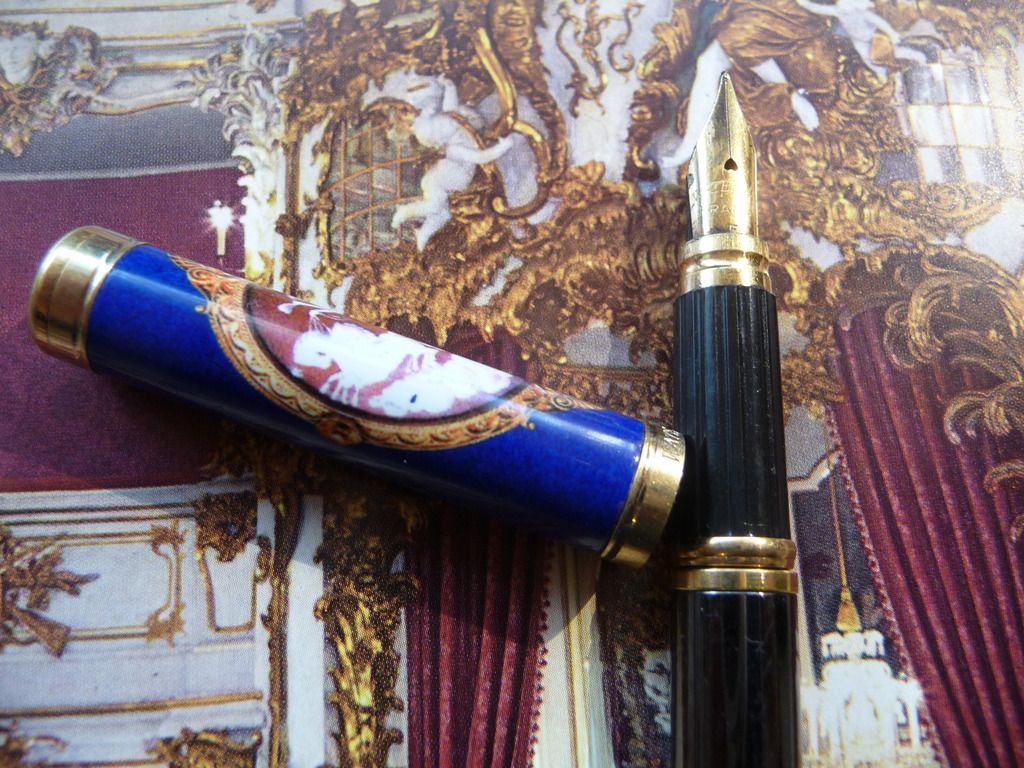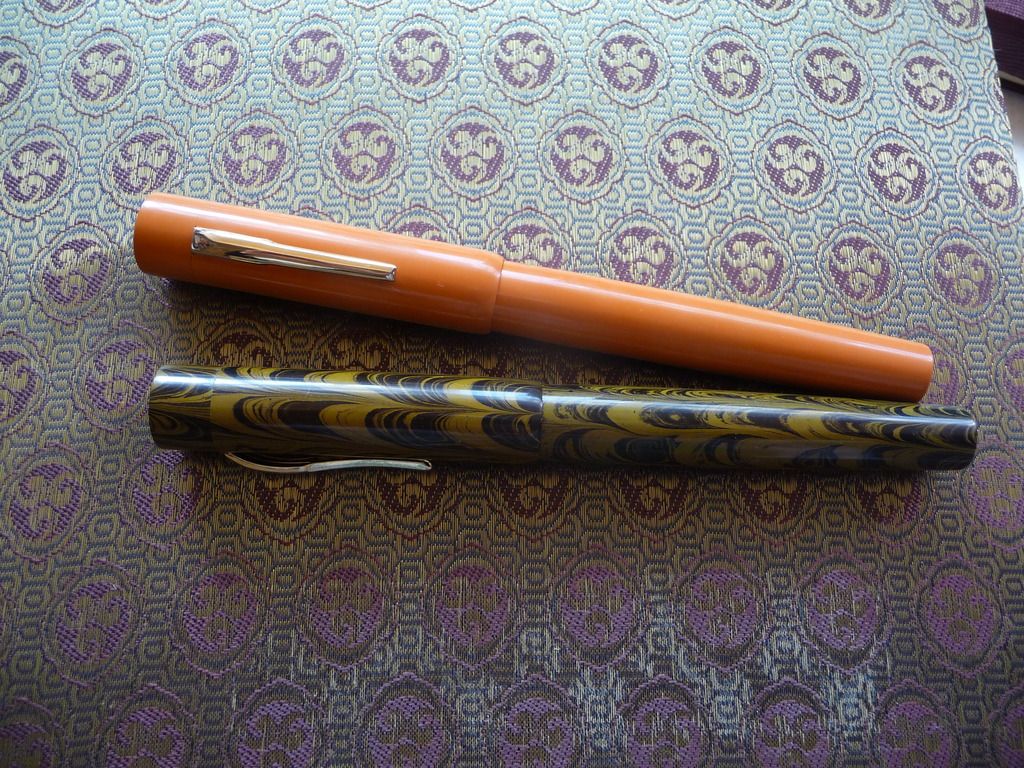A set of pens that intrigue me, and of which I have a small but growing collection, is the Waterman 'Lady' series. These sweet little handbag pens are all based on the same model, a tubular body - if you shrank a Laureate and took the clip off, you'd be most of the way there - but with different materials and finishes.
Two of these pens particularly delight me because Waterman under its visionary CEO Francine Gomez took the unusual step of making them from vintage galalith. The Lady Agathe is the upmarket one, and came in its own little tubular carrying case made of the same material as the pen, with a gold nib; the Lady Elsa is a little less splendid, and came in a leather pouch, with a gold plated steel nib.
Then there's the Lady Alice, in gold or silver plate; the Lady Charlotte, in lacquer finish (some in a delightful eggshell crazed pattern); the Lady Patricia, a metal pen with a carved chequerboard finish; and the Lady Anastasia, which has a printed little baroque cartouche reminiscent of St Petersburg's golden age on the cap (there's also the 'Reve Latin' version which has a more southern influence).
The Anastasia is very recognisable, so when I saw a royal blue cap in a box of junk at a car boot I was quite excited. The excitement didn't last - the cap was all there was left of the pen, with a section firmly gummed into the cap so I couldn't see whether it had a nib or not. Still, the price demanded (20 euro cents) seemed more than fair, so off I went.
Now, one of the great things about modern Watermans is that many of the components are interchangeable. Nibs often fit more than one pen, so I thought I had a reasonable chance of finding a barrel that would fit, either in my parts box or as a temporary fix borrowing from another pen.
I've picked up quite a few modern Watermans at sales, and I had a Laureate rollerball in gunmetal that has a slimmer body than the fountain pens in that range. I tried it. Hurrah! It worked! At least that sorted out the issue of how to get the section out of the cap, and showed that the pen had a gold plated steel nib, in perfect condition, and (if you look closely you can see it) with a heart-shaped breather hole. I rather like that - at the same time complementing the feminine nature of the pen, and providing a reference back to Waterman's early history.
The resulting pen is ugly - the colour clashes and the barrel is way too long for the pen - but I can use it, and the nib is a good little writer, like most Watermans of this era.
Flushed with my success, I now have another victim on my operating table: a Lady Patricia, bought without a nib, which is going to get a transplant from an Executive.
Two of these pens particularly delight me because Waterman under its visionary CEO Francine Gomez took the unusual step of making them from vintage galalith. The Lady Agathe is the upmarket one, and came in its own little tubular carrying case made of the same material as the pen, with a gold nib; the Lady Elsa is a little less splendid, and came in a leather pouch, with a gold plated steel nib.
Then there's the Lady Alice, in gold or silver plate; the Lady Charlotte, in lacquer finish (some in a delightful eggshell crazed pattern); the Lady Patricia, a metal pen with a carved chequerboard finish; and the Lady Anastasia, which has a printed little baroque cartouche reminiscent of St Petersburg's golden age on the cap (there's also the 'Reve Latin' version which has a more southern influence).
The Anastasia is very recognisable, so when I saw a royal blue cap in a box of junk at a car boot I was quite excited. The excitement didn't last - the cap was all there was left of the pen, with a section firmly gummed into the cap so I couldn't see whether it had a nib or not. Still, the price demanded (20 euro cents) seemed more than fair, so off I went.
 |
| Baroque beauty |
I've picked up quite a few modern Watermans at sales, and I had a Laureate rollerball in gunmetal that has a slimmer body than the fountain pens in that range. I tried it. Hurrah! It worked! At least that sorted out the issue of how to get the section out of the cap, and showed that the pen had a gold plated steel nib, in perfect condition, and (if you look closely you can see it) with a heart-shaped breather hole. I rather like that - at the same time complementing the feminine nature of the pen, and providing a reference back to Waterman's early history.
The resulting pen is ugly - the colour clashes and the barrel is way too long for the pen - but I can use it, and the nib is a good little writer, like most Watermans of this era.
 |
| Ugly. Ugly. Ugly. But it works. |
Flushed with my success, I now have another victim on my operating table: a Lady Patricia, bought without a nib, which is going to get a transplant from an Executive.


